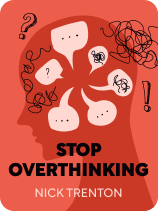

This article is an excerpt from the Shortform book guide to "Stop Overthinking" by Nick Trenton. Shortform has the world's best summaries and analyses of books you should be reading.
Like this article? Sign up for a free trial here.
Why should you observe your emotions in a stressful situation? How do you detach from your emotions?
In Stop Overthinking by Nick Trenton, you learn that one of the key ways to respond to a stressful event is to observe your emotions. That way, you’re less likely to fret about the event and how it’ll affect you in the future.
Check out how to detach from your emotions so you can cope with stress.
Being Curious About a Stressful Event
One way to process stressful events is to be open-minded and curious about your response to them. Instead of judging your thoughts, simply learn how to detach from your emotions. Detachment isn’t necessarily as bad as it sounds. It just means that in a situation where you’ve reacted negatively, you can find a way to look at it positively. When you focus on being curious, you’re less likely to get caught up in feeling bad about yourself and how you reacted, which improves your ability to cope with stress.
(Shortform note: In Unwinding Anxiety, Judson Brewer provides strategies on how you can be more curious about your thoughts: encourage curiosity by paying attention to your breathing or even widening your eyes. These strategies disrupt your anxious thoughts and allow you to observe them from a more neutral standpoint. Another technique he recommends is saying “hmm” to yourself when you’re feeling stressed to trigger yourself into being curious rather than frustrated.)
To be curious rather than judgmental about your thoughts and emotions, Trenton argues you must first separate your personal identity from your problems—such as your tendency to overthink. Rather than trying to fix yourself, think about it as finding solutions to external problems that you’re just experiencing. When you distance yourself from your problems, you gain a sense of control and open yourself to new perspectives that can help you solve them.
(Shortform note: In Chatter, Ethan Kross agrees with Trenton on the importance of detaching yourself from your problems and recommends you avoid using the first-person “I” pronoun in your thoughts. He explains that other pronouns such as “you,” “he,” “she,” or “they” don’t trigger your threat response as much and that people tend to experience fewer negative emotions when using these pronouns.)
Trenton suggests you use mantras and visualization to detach from your thoughts and emotions. A mantra is a statement you can repeat as a reminder to, for instance, distance yourself from your problems—“This problem doesn’t define me.” Visualization allows you to practice putting distance between yourself and your problems through your imagination. For example, imagine putting your stressful thoughts in a bottle and sending them out to sea.
(Shortform note: Trenton doesn’t explicitly define what a mantra is. Traditionally, a mantra is a calming sound or word spoken in Sanskrit that is used to focus during meditations. In a more modern sense, however, a mantra is a positive statement that focuses your intentions and supports self-esteem. Visualization is a form of meditation that can also be useful beyond helping you gain distance from your negative thoughts and problems. Imagining peaceful images can have other mental health benefits such as reducing symptoms of depression and anxiety, and it even has the potential to relieve physical pain or discomfort.)
You can even distance yourself from your anxious thoughts by personifying them or by seeing the humor in a situation. When you personify your thoughts, you give them a form outside of yourself, which allows you to analyze them with curiosity. One way Trenton suggests you do this is by imagining your anxious thoughts as a chatty friend trying to tell you a story. You can also personify your thoughts by giving them a silly name. For example, if you’re feeling guilty about a past mistake you made at work, give that moment a name like, “The Old Work Chronicle.”
Finding humor allows you to distance yourself by creating a new perspective on the situation that puts you in control. For example, if you’re embarrassed because a teacher called on you during class and you didn’t have the answer, picture what you must have looked like at that moment—perhaps like a character from your favorite cartoon caught in headlights.
(Shortform note: In The Happiness Trap, Russ Harris offers additional insights on how you can gain distance from your anxious thoughts, a process which he refers to as defusion. To separate yourself from your thoughts and emotions, he advises you to recognize them as only a story—nothing more than words and images—instead of as fact. By doing this, you diminish the control of your negative thoughts. Like Trenton, he also advises you to give your thoughts another voice, such as imagining a cartoon character saying them.)

———End of Preview———
Like what you just read? Read the rest of the world's best book summary and analysis of Nick Trenton's "Stop Overthinking" at Shortform.
Here's what you'll find in our full Stop Overthinking summary:
- What overthinking is and how it’s connected to stress and anxiety
- Ways you can manage stress before, during, and after it happens
- How to conquer your habit of overthinking with long-term solutions






